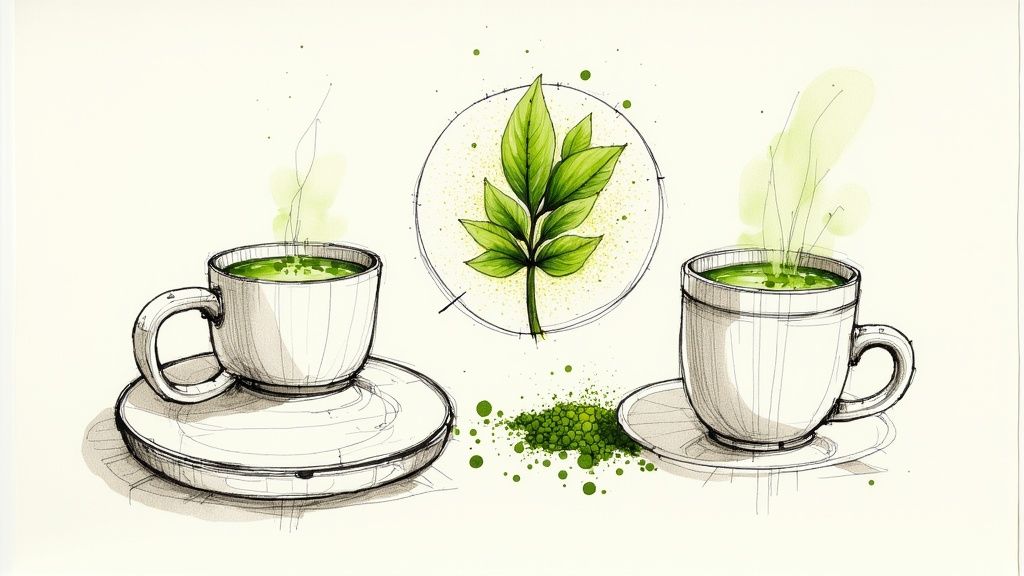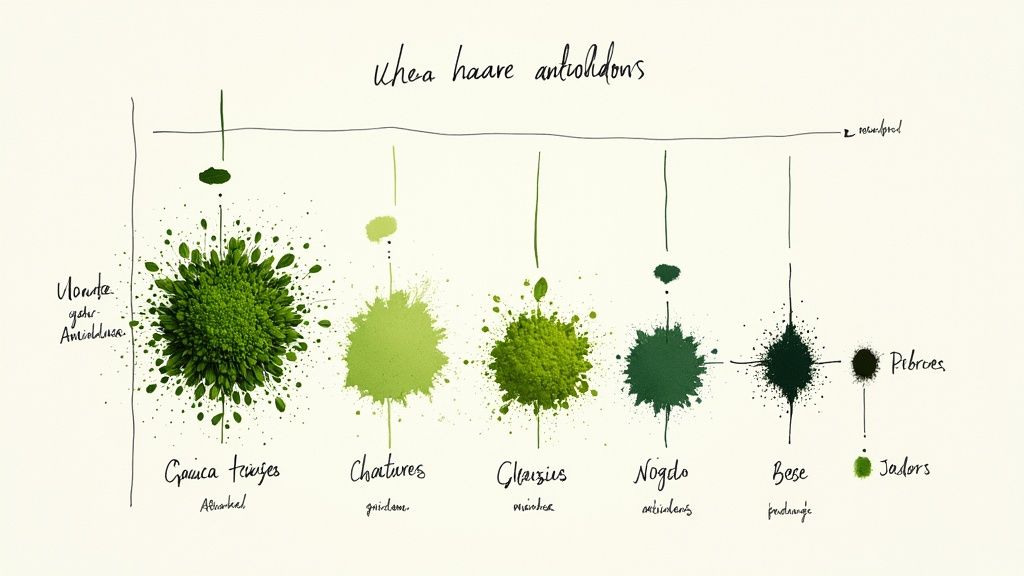Beyond Basic Matcha Nutrition Facts

The bright green color of matcha catches your eye, but its impressive nutritional content is what makes this tea powder truly special. Looking deeper into matcha's makeup reveals why it offers more health benefits than regular green tea. Let's explore what makes matcha such a nutritionally rich drink.
Unpacking the Nutrient Density of Matcha
Just one small serving of matcha (1 gram or ½ teaspoon) contains an impressive array of nutrients. Each serving provides 385mg of dietary fiber, which helps keep your digestion running smoothly and your blood sugar stable. You'll also find 306mg of protein and 272mg of amino acids per serving – essential building blocks your body needs.
Adding matcha to your daily routine can help boost your intake of these key nutrients naturally. While many foods get labeled as "superfoods" these days, matcha's concentrated nutrition actually backs up this claim. But what makes matcha special isn't just the amount of nutrients – it's how they work together in your body.
The Synergy of Matcha's Nutritional Components
The nutrients in matcha work together like a well-coordinated team. For example, you'll find important minerals like potassium (27mg/g), magnesium (2.3mg/g), and calcium (4.2mg/g). These minerals help with essential functions like muscle movement, nerve signaling, bone strength, and fluid balance. The potassium and magnesium are particularly good for heart health and normal blood pressure.
Matcha also provides significant vitamin content, especially Vitamin A (580μg/g). In fact, just 2 grams of matcha powder can give you most of your daily Vitamin A needs – crucial for healthy vision, immune function, and cell growth. Think of matcha's nutrients like musicians in an orchestra – each plays its own part, but together they create something even more powerful.
Matcha and Your Daily Diet
Knowing matcha's nutritional profile helps you use it more effectively in your diet. You can track how matcha contributes to your daily nutrition using apps like MyFitnessPal. This knowledge lets you make smart choices about including matcha in your meals and snacks. As you learn which nutrients matcha provides, you can better understand how it fills gaps in your current diet and supports your overall health. In the next section, we'll dive into what makes matcha such a powerful source of antioxidants.
The Truth About Matcha's Antioxidant Power
What makes matcha such a powerful drink? While it's known for its antioxidant content, understanding the real science behind these properties helps explain why this traditional Japanese tea delivers unique health benefits. Let's look at what the research actually shows about matcha's nutritional profile.
Deconstructing the Dynamic Duo: EGCG and Catechins
At its core, matcha is rich in compounds called catechins – naturally occurring antioxidants that give the tea its health-boosting properties. The most important of these is EGCG (epigallocatechin gallate). A single serving of matcha contains 17.5mg/g of EGCG compared to regular green tea's 0.05mg/g. This high concentration comes from matcha's unique growing process – farmers shade the tea plants for several weeks before harvest, which naturally increases these beneficial compounds.
These catechins work as your body's natural defense system. They help neutralize unstable molecules called free radicals that can damage cells and speed up aging. Think of catechins as protective shields that surround your cells, preventing harmful compounds from causing damage. This cellular protection explains many of matcha's health benefits.
Separating Fact from Fiction: Validating Health Claims
The research on matcha's health effects shows real promise, though some claims need more study. For instance, studies suggest matcha's high EGCG levels may help protect cells from DNA damage, potentially reducing cancer risk. While this doesn't mean matcha prevents cancer, it points to its role in supporting overall health.
Studies also show matcha's antioxidants support heart health. A review in the European Journal of Nutrition found that catechins help lower blood pressure and LDL cholesterol by reducing inflammation and oxidative stress. Still, matcha works best as part of healthy habits – it complements but doesn't replace good nutrition and exercise.
Matcha vs. Other Superfoods: A Comparative Analysis
How does matcha compare to other antioxidant-rich foods? While blueberries and other fruits pack plenty of antioxidants, matcha offers a unique and concentrated form of EGCG. To see how different foods stack up, you can use tools like Cronometer to compare their nutritional content. This helps you choose the best mix of antioxidant sources for your diet.
Preparation Matters: Maximizing Antioxidant Absorption
The way you prepare matcha affects how many antioxidants you actually absorb. Water that's too hot can break down the catechins – aim for about 175°F (80°C) for the best results. Adding a squeeze of lemon helps too, since vitamin C makes it easier for your body to absorb the catechins. These simple steps help you get the most benefit from your daily matcha.
Essential Nutrients You're Actually Getting

The bright green color of matcha tells us a lot about what's inside. This finely ground tea powder packs an impressive array of vitamins and minerals into each serving. Let's break down exactly what nutrients you get when you drink matcha and in what amounts, so you can make informed choices about including it in your diet.
Vitamins and Minerals: A Closer Look
In just one gram (about half a teaspoon) of matcha, you'll find several key nutrients. The tea contains 580μg of Vitamin A, which helps keep your eyes healthy, supports your immune system, and promotes normal cell growth. This single serving gives you a good portion of your daily Vitamin A needs. You'll also get 58μg of Vitamin K per gram, which your body needs for proper blood clotting and strong bones. While matcha has less Vitamin C than regular green tea because of how it's grown in the shade, you still get about 1mg per gram.
The mineral content in matcha is equally impressive. Each gram provides 27mg of potassium, which helps your muscles work properly and keeps your nerves sending signals correctly. You'll also find 2.3mg of magnesium, which your body uses for many functions including making proteins and controlling blood sugar. The tea provides 4.2mg of calcium for bone strength, plus small amounts of iron, zinc, and phosphorus. These minerals work together to support your overall health. For more details about getting the most from your matcha, check out: How to master… the art of matcha preparation.
Maximizing Nutrient Bioavailability
Knowing what's in your matcha is just the first step – it's also important to understand how well your body can use these nutrients. This concept, called bioavailability, determines how much of each nutrient actually makes it into your bloodstream. For example, adding a squeeze of lemon to your matcha can help your body absorb more of its iron content, since Vitamin C improves iron absorption.
The water temperature you use also makes a difference in keeping nutrients intact. Very hot water can break down certain vitamins, especially Vitamin C. Using water at about 175°F (80°C) helps preserve these nutrients better. To keep track of how matcha fits into your overall nutrition, you might find it helpful to use tools like MyFitnessPal. By paying attention to both the nutrients in matcha and how you prepare it, you'll get the greatest benefit from each cup.
Human style similar to examples:
Heart Health and Blood Sugar Balance
When it comes to your health, matcha offers specific benefits for your heart and blood sugar levels. Regular consumption can help maintain cardiovascular wellness and keep glucose levels steady throughout the day. Let's take a closer look at what research tells us about these important health effects.
Matcha and Blood Pressure Regulation
Research shows that drinking matcha regularly can help keep blood pressure in check. The tea's catechins, especially EGCG, work to improve how blood vessels function while reducing harmful oxidative stress – two key factors in maintaining healthy blood pressure. While other teas offer similar benefits, matcha packs a stronger punch since it's more concentrated. For instance, studies have found that people who drink matcha regularly tend to see modest improvements in both their systolic and diastolic blood pressure numbers.
Cholesterol Management and Matcha
Matcha doesn't just help with blood pressure – it also supports healthy cholesterol levels. Studies show its natural compounds can help reduce LDL (the "bad" cholesterol) by making it harder for cholesterol to be absorbed in your digestive system and easier for your body to remove it. By helping maintain better cholesterol numbers, matcha may lower your risk of developing plaque buildup in your arteries – an important factor in preventing heart disease.
Matcha's Impact on Glucose Regulation
New studies suggest matcha can help your body manage blood sugar more effectively. The tea appears to boost insulin sensitivity, which means your cells can better use glucose for energy. This helps prevent the ups and downs in blood sugar that can leave you feeling tired and hungry. Plus, the natural fiber in matcha slows down digestion, which also helps keep blood sugar steady. To learn more about getting these benefits from matcha, check out matcha-tea.com.
Practical Applications for a Heart-Healthy Lifestyle
Making matcha part of your heart-healthy routine is straightforward and enjoyable. Start with quality matcha powder and brew it properly – using water around 175°F (80°C) helps preserve its beneficial compounds. You can boost its effects by pairing matcha with other healthy habits. Try drinking it alongside meals rich in fruits, vegetables and whole grains. Remember that regular exercise, good stress management, and proper sleep all work together with matcha to support your heart health and blood sugar control. While matcha alone offers great benefits, it works best as part of an overall healthy lifestyle.
The Energy-Focus Connection

Looking for steady energy without the crash? That's where matcha comes in. While many of us reach for coffee when we need a boost, matcha offers something different – a balanced combination of caffeine and L-theanine that works together to provide lasting energy and mental clarity, without the jitters that often come with other caffeinated drinks.
The Caffeine-L-Theanine Synergy
A serving of matcha contains about 68mg of caffeine – less than coffee but more than regular green tea. What makes matcha special is how this caffeine works with L-theanine, a calming amino acid found in the tea. L-theanine helps create alpha brain waves, putting you in a state of alert relaxation. So instead of a sudden jolt followed by a crash, you get smooth, sustained energy that keeps you focused longer. Think of it as a gentle lift rather than a dramatic spike.
Timing Your Matcha for Optimal Performance
When you drink your matcha matters. Many people find that starting their day with matcha instead of coffee sets them up for steady focus throughout the morning. Others enjoy a mid-afternoon cup to beat the post-lunch slump and stay sharp for the rest of the workday. Since everyone responds differently to caffeine and L-theanine, pay attention to how matcha affects you and adjust your timing accordingly. For more details on getting the most from your matcha, check out matcha-tea.com.
Matcha vs. Coffee: A Tale of Two Stimulants
Coffee and matcha affect your body quite differently. Coffee hits fast and hard – you feel alert quickly, but that energy often vanishes just as rapidly. Matcha works more gradually because of its unique caffeine-L-theanine combination. It's like comparing a sprint to a marathon: coffee gives you a quick burst of speed, while matcha helps you maintain steady energy over the long haul. This makes matcha especially helpful when you need to stay focused and clear-headed for extended periods.
Making Matcha Work for You

Now that you understand matcha's nutritional profile, let's look at practical ways to make it part of your daily routine. Getting the most out of matcha means knowing how to select quality powder, store it properly, and prepare it to preserve its benefits.
Selecting and Storing Your Matcha
Quality matcha has distinct characteristics to look for. The powder should be vibrant, almost emerald green in color and feel silky smooth between your fingers, not grainy. Japanese matcha, especially from regions like Uji and Nishio, often offers superior quality due to traditional growing methods.
Once you have good matcha, proper storage is essential to maintain its freshness. Like many fine teas, matcha can lose flavor and nutrients through oxidation. Keep it in an airtight container away from light, heat, and moisture. The refrigerator is ideal – think of matcha like fresh herbs that need protection to stay potent. This care helps preserve important nutrients, including that valuable 385mg of dietary fiber per gram.
Mastering Matcha Preparation
How you prepare matcha directly affects both its taste and health benefits. While it might seem faster to use boiling water, this actually damages the tea's beneficial compounds. Instead, use water around 175°F (80°C). This gentler temperature protects the antioxidants, including 17.5mg/g of EGCG, letting you get the full benefits from each cup.
A simple trick to boost matcha's benefits is adding a splash of lemon juice. The vitamin C helps your body absorb more iron and other nutrients from the tea. Small adjustments like these make a real difference in how well your body uses matcha's nutrients.
Tailoring Matcha to Your Goals
One of matcha's strengths is how well it fits different health needs. The fiber helps control appetite for those watching their weight. Athletes appreciate the steady energy from its unique combination of caffeine and L-theanine.
Here's how to match your matcha habits to specific goals:
- Weight Management: Mix matcha into smoothies or drink it plain instead of sugary beverages. The fiber helps you feel full longer.
- Energy Boost: Have a cup in the morning or afternoon for steady focus without jitters.
- Athletic Performance: Drink matcha before workouts. Its 272mg of amino acids per gram support muscle function.
- Overall Wellness: Make matcha a daily ritual as part of balanced nutrition.
Pay attention to how matcha affects you personally. Keep notes on changes in your energy, weight, or athletic performance. This helps you adjust your routine for the best results. For more tips and information about making the most of matcha, visit matcha-tea.com. Their guides cover everything from nutrition facts to recipes that celebrate this remarkable green tea.
